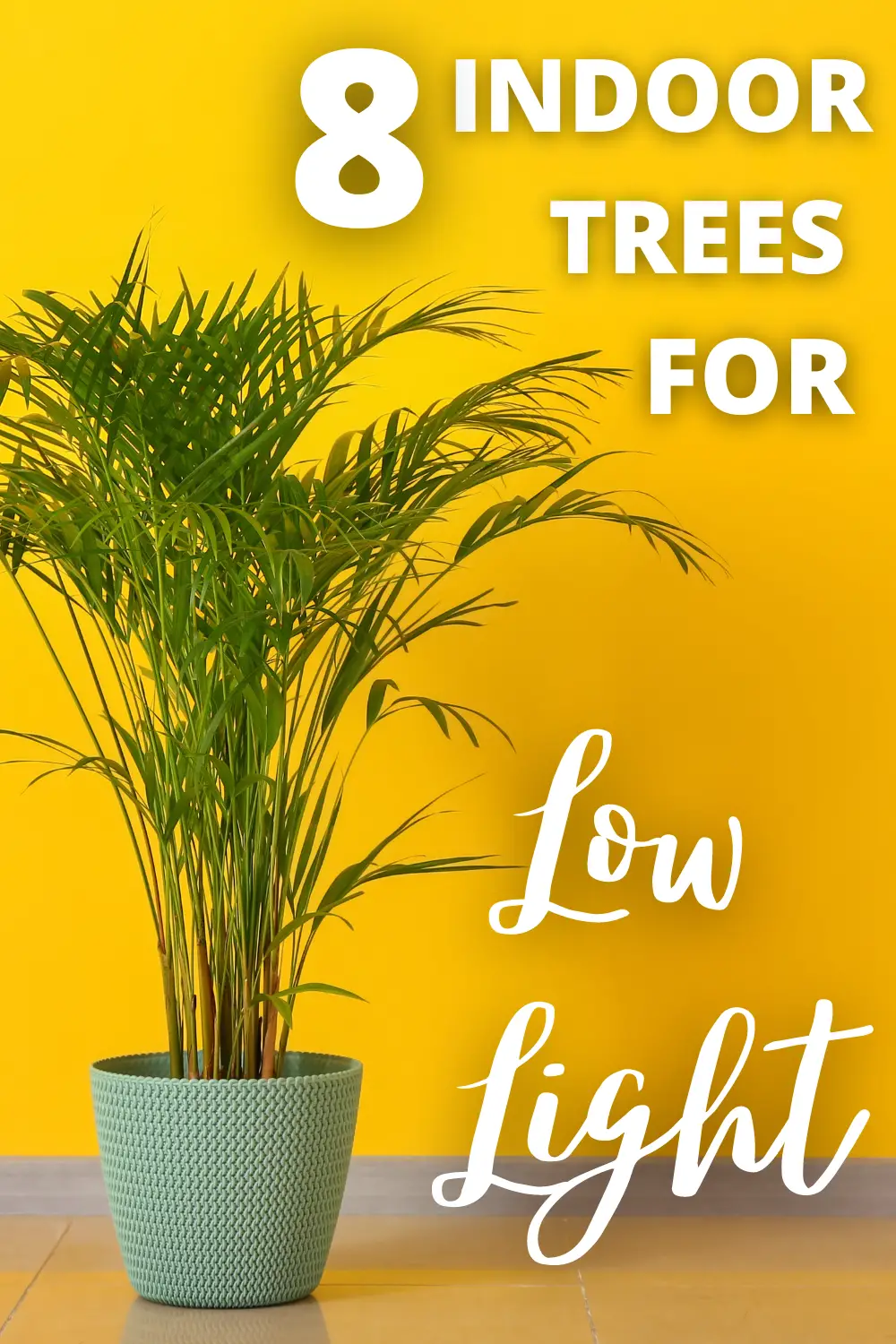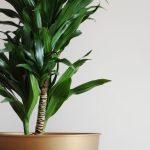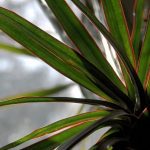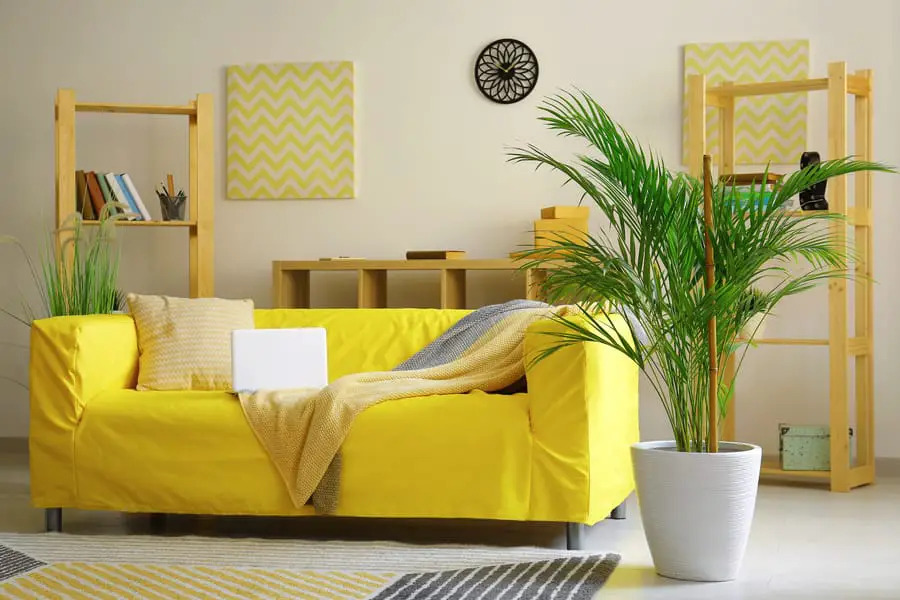
We bought our first house with no idea that we should pay attention to the windows and sunlight for growing houseplants. We ended up in a home with many low light areas. Over the years we’ve found several trees that survive and even thrive in indirect or filtered light.
Here’s a list of the best low light indoor trees:
- Areca Palm
- Lady Palm
- Dragon Tree
- Rubber Plant
- Neanthe Bella Palm
- Janet Craig Dracaena
- Corn Plant
- Kentia Palm
As you can see, many varieties of palm and Dracaena do well in low light. Let’s take a closer look at these plants and their light requirements.
#1 – Areca Palm
Dypsis lutescens, commonly known as the Areca Palm, is on the easiest trees to grow indoors. It only needs filtered light and tolerates lower light conditions. Although you can restrict its size by keeping it in a smaller container, the Areca can grow six to seven feet tall in a large enough pot. With adequate light, the tree produces small white flowers and purple fruit nearly year-round.
Areca palm can tolerate brighter light – such as in a south-facing window. But it also does well in the lower light of an east- or west-facing window. We’ve grown this tree in a corner near a window where it only receives indirect, filtered sunlight for part of the day and it’s done quite well.
#2 – Lady Palms
Another palm tree species that adapts well to low light indoors is the Rhaphis species, also known as Lady Palms. According to the Clemson Cooperative Extension, these palms are the most adaptable to low light areas.
In our experience, the Areca palm performs slightly better. But the Large Lady Palm is a close second. Put her in an area that gets filtered, indirect light for most of the day and she’ll grow beautifully. Lady Palm are easy to grow, with the large variety reaching up to 14 feet in height when potted in a big enough container.
There are three types of Lady Palm commonly grown indoors – Large, Miniature, and Thailand. The Large Lady Palm is the best for low light.
#3 – Dragon Tree
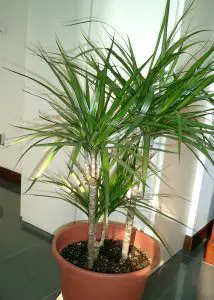
Dracaena marginata, commonly known as Dragon Tree or Madagascar Dragon Tree, is an excellent choice for low light areas. It’s often found growing in homes, offices, and commercial settings since it doesn’t need direct sunlight.
Dragon Tree can reach 10 to 15 feet in height under the right conditions, but cutting back the stems will encourage lower, bushier growth.
The D. Marginata cultivar known as ‘Tricolor’ also thrives in low light, producing narrow green leaves with cream and red stripes. The original variety produces leaves with gorgeous purple margins.
Both types are strikingly beautiful and make great additions to any lower light areas of your home.
#4 – Rubber Plant
The Rubber Plant (Ficus elastica), also known as India Rubber Tree, is another easy-to-grow indoor tree also frequently found in offices and commercial buildings. It’s a great houseplant for beginners, as it’s very forgiving. The plant prefers indirect and low light conditions. It thrives in an east-facing window that receives some morning sunlight.
Indoors, the Rubber Plant can reach heights of up to 10 feet. In its native tropical environment, the plant grows up to 100 feet tall! With beautiful, glossy, oval leaves that reach up to one foot long, it makes a beautiful centerpiece in areas that don’t get much light. The Rubber Plant was my very first houseplant, and I still love it to this day.
In very low light, Rubber Plants may grow tall and lanky. Prune them back in spring just as new growth begins to make them bushier and more attractive.
#5 – Neanthe Bella Palm
The third palm on our list, Neanthe Bella Palm (also known as Parlor Palm), is ideal for offices and rooms where little or no outside light is available. It will thrive under fluorescent ceiling lights if necessary. These Parlor Palms were so named because during Victorian times, they were popular in the poorly lit parlors of Victorian homes.
Although shrubby, this slow-growing plant reaches up to six feet in height with a four-foot spread. It’s one of the most popular indoor palms because it thrives in conditions that many other palms and indoor trees can’t tolerate. Easy to grow and requiring less humidity than other palms, it only needs adequate moisture and low light to perform well indoors.
#6 – Janet Craig Dracaena
The second Dracaena on our list, Janet Craig (Dracaena deremensis) – also known as Striped Dracaena – is another popular low-light indoor tree. It thrives in low light levels and will even burn if placed in direct sunlight. The fountain-like leaves make this plant a great choice for brightening up a dark corner or an area of your home that needs more life.
Janet Craig reaches up to 10 feet in height when grown indoors, but it will take many years for the slow-growing plant to reach its peak. Keep it smaller by cutting off the tops and using them as cuttings.
A compact variety – ‘Janet Craig Compacta’ – also tolerates low light, but it is smaller and more shrub-like than the original – which is more of a small tree.
#7 – Corn Plant
Often grown as a small indoor tree, the Corn Plant (Dracaena fragrans) likes low light conditions with filtered or indirect light providing the best environment. The foliage will even burn if subjected to direct sunlight. Corn plant prefers an east, north, or west-facing window. If only a south-facing window is available, place it a few feet back to prevent scorching the leaves.
Reaching up to six feet in height, Corn Plant has tall, strappy leaves and wooden stems that make for a beautiful, dramatic display. It’s typically sold in a container with three stems – each of a different height – supporting a fountain of green leaves. Variegated cultivars require more light to keep their variegation. For low light areas, stick to the original variety.
#8 – Kentia Palm
Finally, our third palm on the list – Kentia Palm (Howea forsteriana). This small tree has a cast-iron constitution and can live for many years in low light conditions. Like the Parlor Palm, it’s popular as a houseplant where other palms may not survive due to lack of light. Kentia can even tolerate low humidity – a rarity among palms.
The Kentia Palm has been a favorite indoor tree for centuries thanks to its forgiving nature and tolerance of less than ideal conditions. It’s a slow grower, however, especially in low light. For the best results, buy a Kentia Palm around the size you want it to remain. And don’t expect it to get much bigger if you’re placing it in a darker area of your home.
Trees Often Called Low Light but Really Aren’t
I’ve seen many articles online that say they’re listing low-light plants and trees. Most of them are wrong. There are only a few true trees or tree-like plants that can really be grown in low light. Believe me. I’ve tried them all in my dark house over the past 20 years, and I know which ones thrive and which ones don’t.
These trees are commonly touted as low light (but really aren’t):
- Weeping Fig – Can tolerate some low light, but still requires some higher intensity light each day. It will drop leaves if light levels are too low.
- Fiddle-Leaf Fig – Needs lots of bright, indirect sunlight.
- Norfolk Island Pine – Yes, it tolerates low light. But to really thrive, this indoor evergreen needs brighter light conditions. Too little light results in less dense foliage, a weaker trunk, slower growth, and lower limbs dropping off.
- Fishtail Palm – I’ve seen Fishtail Palm listed time and again as a good choice for low light, but this plant really prefers a higher light intensity.
- Umbrella Tree – Easy to grow indoors, the Umbrella Tree really grows best in bright, indirect light. It needs at least three to four hours of indirect sun each day (and that’s not what I would really consider “low light”). I almost killed my first Umbrella Tree because I didn’t give it enough light.
- Yucca – These small trees will stay alive indoors with little light for a long time. But they won’t thrive and grow without lots of bright light.
Remember, there’s a difference between surviving and thriving. Just because a plant or tree tolerates low light doesn’t mean it will truly grow well under these conditions. If you really need a low light tree for your home, choose one from the eight featured in this article and you won’t be disappointed.

